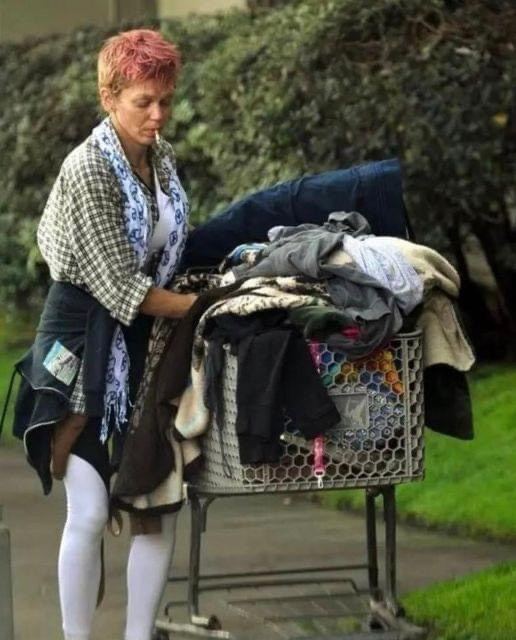Loni Willison, once a rising star with a promising career in the entertainment industry, has faced a heartbreaking decline, transitioning from Hollywood’s glitz and glamour to the harsh reality of homelessness on the streets of Los Angeles. Born in Riverside, California, in 1983, she had a brief stint as an actress and model but is now barely recognizable, pushing a shopping cart filled with her belongings and searching through dumpsters for food. Her tragic downfall has left many stunned, raising questions about the impact of personal struggles, mental health issues, and substance abuse.

Reports of Willison’s struggles first surfaced in 2016 when she was spotted living on the streets. Over time, her situation deteriorated, and she was seen in increasingly dire conditions, visibly unkempt, with missing teeth and a frail appearance. Once a blonde bombshell gracing red carpets, she now fights for survival in a world far removed from the one she once knew.
A significant turning point in her downfall appears to be her turbulent relationship with Baywatch actor Jeremy Jackson. The two married in 2012, but their union was short-lived, marked by volatility and an alleged violent altercation in 2014. Reports indicate that the couple had been drinking when a heated argument turned physical, with Jackson allegedly strangling Willison. Following this traumatic incident, the couple separated, finalizing their divorce in 2015. The emotional scars left by the failed marriage seemingly triggered a downward spiral that she struggled to recover from.
The physical and emotional toll of the altercation was severe. Willison spent two months recovering from injuries, including broken ribs and scratches. In the aftermath, she found herself unable to return to her previous career, saying, “I couldn’t work out or take on any modeling jobs.” Despite the trauma, she chose not to press charges against Jackson, instead internalizing the weight of her failed relationship and the impact it had on her life.
The fallout from the divorce led to further hardships. Willison lost her job as an assistant at a plastic surgery clinic, and without a steady income, she soon found herself unable to maintain her lifestyle. Struggling with depression, she turned to substance abuse, which further exacerbated her problems. By 2018, she was also battling severe mental illness, exhibiting paranoia and delusions, even claiming that she was being tortured with electricity.
With no job, no home, and no reliable support system, Willison was evicted and forced to live on the streets. Over the years, she has adapted to a life of survival, relying on scavenging for food and occasional handouts. She has been seen pushing a shopping cart through Santa Monica, carrying the few possessions she has left. Despite her struggles, she has made it clear that she has no interest in receiving help. In a rare interview, she stated, “I haven’t got a cell phone. I’ve got food, and I’ve got a place to sleep. I get money here and there, and there’s food in the bins and near the stores. There’s lots here.” Her words suggest a sense of resignation, as if she has accepted that this is her reality.
Efforts have been made to provide her with assistance, but she has resisted. Larry Marinelli, the owner of True Intensions, a sober living home, once offered Willison free treatment in an attempt to help her get back on her feet. However, she checked out less than 24 hours later, refusing to accept the help. “I haven’t spoken to Jeremy. I don’t want to speak to my friends. I’m doing just fine. I don’t want anyone to help me,” she insisted. Her refusal of support has left those who once knew her feeling helpless, watching her deteriorate without being able to intervene.
Her tragic story is a stark reminder of the broader crisis of homelessness, addiction, and mental health struggles in America. Substance abuse continues to be a growing epidemic, with an estimated 48.7 million people aged 12 or older admitting to having a substance use disorder in 2022. Additionally, one in three adults in the U.S. has experienced a mental health or addiction-related issue. Willison’s situation highlights how even those who once lived in the spotlight can find themselves in the depths of despair, struggling with challenges that transcend fame and fortune.
Her transformation from a glamorous Hollywood figure to a woman barely surviving on the streets is difficult to comprehend. Her story forces society to confront the stark reality that financial success and celebrity status do not make anyone immune to personal demons. If anything, it emphasizes the importance of addressing mental health concerns and offering support to those in need before they reach a point of no return.
While some may see Willison as a cautionary tale, her experience is also a call to action. It underscores the need for mental health awareness, accessible rehabilitation services, and compassionate intervention. The fact that she refuses help may not be a choice but rather a symptom of deeper issues that have gone unaddressed for years. Her case is a heartbreaking example of how quickly life can unravel when support systems fail.
At one point, Loni Willison had everything—youth, beauty, a high-profile marriage, and a promising career. Today, she is a woman struggling to survive, a reminder of the fragility of life and the importance of mental well-being. Her story is not just about a fallen celebrity but about the thousands of people who battle similar struggles daily. As she continues her heartbreaking journey, she stands as a symbol of the harsh realities of life on the streets and the urgent need for more effective support for those suffering from addiction and mental illness.





